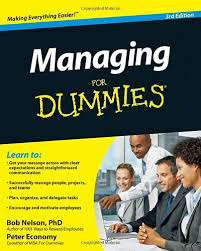 I was at it again. Just this morning I was digging through old boxes in my basement when I came across a copy of the book Managing for Dummies. After a few quick nostalgic turns of the page, I came across a section titled “Top ten ways to motivate employees” on page 107. My mind immediately wandered to the resource development implications of this list. So, I thought you and I could explore this question together this wonderful Wednesday morning.
I was at it again. Just this morning I was digging through old boxes in my basement when I came across a copy of the book Managing for Dummies. After a few quick nostalgic turns of the page, I came across a section titled “Top ten ways to motivate employees” on page 107. My mind immediately wandered to the resource development implications of this list. So, I thought you and I could explore this question together this wonderful Wednesday morning.
Here is that list of things to motivate employees from our friends who write “the dummy books“:
- Personally thank employees for doing a good job — one-on-one, in writing, or both. Do it timely, often, and sincerely.
- Be willing to take the time to meet with and listen to employees — as much as they need or want.
- Provide employees specific and frequent feedback about their performance. Support them in improving performance.
- Recognize, reward, and promote high performers; deal with low and marginal performer so that they improve or leave.
- Provide information on how the company makes and loses money, upcoming products, and services and strategies for competing. Explain the employee’s role in the overall plan.
- Involve employees in decisions, especially as those decisions affect them. Involvement equals commitment.
- Give employees a chance to grow and learn new skills; encourage them to be their best. Show them how you can help them meet their goals while achieving the organization’s goals. Create a partnership with each employee.
- Provide employees with a sense of ownership in their work and their work environment. This ownership can be symbolic (for example, business cards for all employees, whether they need them to do their jobs or not).
- Strive to create a work environment that is open, trusting, and fun. Encourage new ideas, suggestions, and initiative. Learn from, rather than punish for, mistakes.
- Celebrate successes — of the company, of the department, and of individuals in it. Take time for team- and morale-building meetings and activities. Be creative and fresh.
I think this list is very close to being able to double as a recipe for donor engagement, but there are obviously a few tweaks here and there that need to occur. So, the first thing I did was strike-through the word employee and replace is with the word donor. Then I went through each tip and modified things that were obviously only relevant to the workplace experience.
 Here is how that new top ten list turned out for donors:
Here is how that new top ten list turned out for donors:
- Personally thank donors for their support — one-on-one, in writing, or both. Do it timely, often, and sincerely.
- Be willing to take the time to meet with and listen to donors — as much as they need or want.
- Provide donors specific and frequent feedback about how your agency is putting their contribution to work. Engage them is discussion along the way on how they would like to see possible future donations used to support the both their agency’s mission and vision along with their personal philanthropic wishes and dreams.
- Recognize major gifts donors in a manner in which they are comfortable; create and implement strategies to move smaller donors up the “resource development pyramid of donors“.
- Provide information on how your non-profit organization raises money, existing products/services as well as upcoming products/services. Explain the different roles in the overall plan (e.g. strategic plan, resource development plan, program plan, etc) that various donors might consider.
- Involve donors in decisions, especially as those decisions affect them. Involvement equals commitment. (This could be via surveys, focus groups, committee involvement, etc)
- Give donors a chance to grow and learn; encourage them to be their philanthropic best. Show them how you can help them meet their charitable giving goals while achieving the organization’s goals. Create a partnership with each donor.
- Provide donors with a sense of ownership in your agency.
- Strive to create a fundraising experience that is open, trusting, and fun. Encourage new ideas, suggestions, and initiative and include these things in your annual resource development plan. Learn from your donors.
- Celebrate successes of your agency and of individual donors.
So, there you have it. When I take a step back and look at these two lists, I see lots of similarities. Do you see the same things? What would you add to these lists? Is there anything you would eliminate?
Please scroll down and share your thoughts and experiences in the comment box. Why? Because we can all learn from each other.
Here’s to your health!
Erik Anderson
Founder & President, The Healthy Non-Profit LLC
www.thehealthynonprofit.com
erik@thehealthynonprofit.com
http://twitter.com/#!/eanderson847
http://www.facebook.com/eanderson847
http://www.linkedin.com/in/erikanderson847
